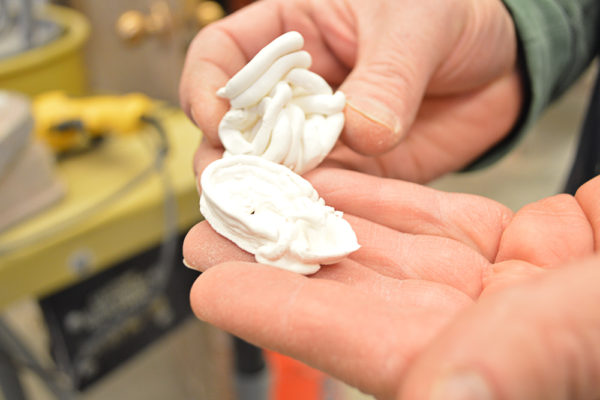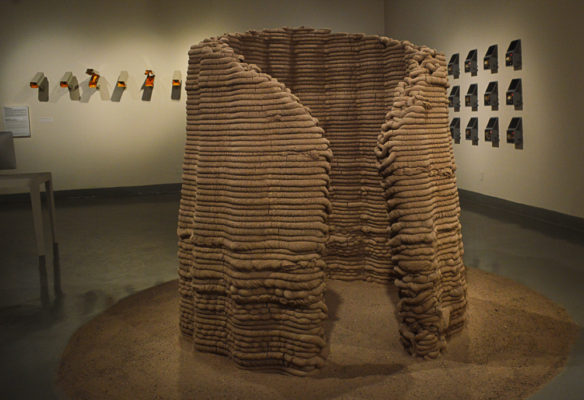A new 3D printer gifted to the UTEP Department of Art will allow art students to break boundaries in the arts to create unique sculptures, models and forms that have the potential to go beyond what they can do with their bare hands and sculpting tools.

The 3D Printer gifted by Ronald Rael and Virginia San Fratello in the process of creating a ceramics vessel.
“It provides an amazing opportunity for them to think about their studio practices in a different way,” said Vincent Burke, associate professor of art who specializes in ceramics. “It brings new technologies, new ways of thinking, new ways of seeing – so it’s a tremendous opportunity for the students.”

Professor Viencent Burke shows the first finished works the ceramics department created with the 3D printer.
Burke said ceramics is known to be labor intensive since most artists use their hands to mold clay. Although the 3D printer does help, it can still be challenging and time consuming as one sculpture can take from 45 minutes to three hours.
“The clay has to be just the right consistency. It needs to be a lot softer than what we would normally work with, it’s almost like a paste-like extrusion,” Burke said. We have to design the work on the computer, feed that to the actual 3D printer. … And then we have to watch it too, we have to be with it the whole time – to make sure its tracking correctly and printing a certain layer thickness correctly. Its very engaging.”

Large adobe structure created by Ronald Rael and Virginia San Fratello using a large scale 3D Printer from California, is on display at the Stanlee and Gerald Rubin Center.
Ronald Rael and Virginia San Fratello, visiting artists with the Gerald Rubin Center for the Visual Arts granted the 3D printer to the UTEP art department in August. UTEP was part of a three institution collaboration with Southern Methodist University and Arizona State University to create the “Sections: New Cities, Future Ruins at the Border” exhibition in the Rubin Center which created works that represent the environment throughout the southwestern United States.
“Our exhibition focuses on the border, and we invited Ronald Rael and Virginia San Fratello to do an installation that is based on the concept of ‘earth at the border’ — and that’s where the 3D Printing came from,” said Kerry Doyel, Rubin Center director.
A total of 170 different ceramic vessels were designed and created by UTEP art students using the 3D printer to present in the “Mud Frontier” section in the “Sections: New Cities, Future Ruins at the Border” exhibition.
“We were assigned to created three to however many vessels we wanted and I created, about five last semester that are included in the exhibition,” said Jaqueline Martinez, senior art major.
The works were made from local clays from various sites in the Juárez/ El Paso region.
“I have used a 3D Printer before, but I didn’t think they had 3D printers for ceramics – I thought it was interesting how far technology has come and how interesting the different designs the 3D printer is able to achieve, especially with clay,” Martinez said.
Rael and San Fratello, educators, architects and co-founders of Rael San Fratello, a San-Francisco based studio, created Emerging Objects Corporation, an independent based 3D Printing project that specializes in innovative 3D Printing in architecture and building components. They experiment with unique materials and sizes to create uncommon 3D architecture.
“We are a studio that disrupts the conventions of architecture by tackling topics not typically of interest to architects,” Rael San Fratello say in their studio biography.
In order to represent ‘earth on the border’ for the “Sections: New Cities, Future Ruins at the Border” exhibition Rael and San Fratello visited the Borderland a few times within the past year to investigate the process and do trials with a large 3D printer.
“There are two projects involved with the 3d printing and they both are a mix of history and technology. Ronald Rael and Virginia San Fratello developed a large scale prototype printer that is capable of printing adobe, that they have been working on for a number of years now,” Doyle said. “So they are using traditional adobe mix from the region where they use dirt, sand and straw.”

170 ceramic vessels on display at the Stanlee and Gerald Rubin Center created by UTEP art students using the 3D art printer
UTEP art students will be able to experiment with materials other than clay using the 3D printer in the future.
“Pretty much anything you can get through that machine it’ll print,” Burke said. “Ron and Virginia have experimented with a lot of materials, they’ve printed sawdust material, salt, coffee.”
Currently the 3D printer is available only to ceramics students who take a course to learn how to use it properly.
However, Burke said local artists involved with the UTEP community are in the process of planning to partner with Burke and UTEP to create art using the 3D printer for future art projects.
The show will be in the center’s large Rubin Gallery through April 6. The National Endowment for the Arts funded the exhibition and related activities.

